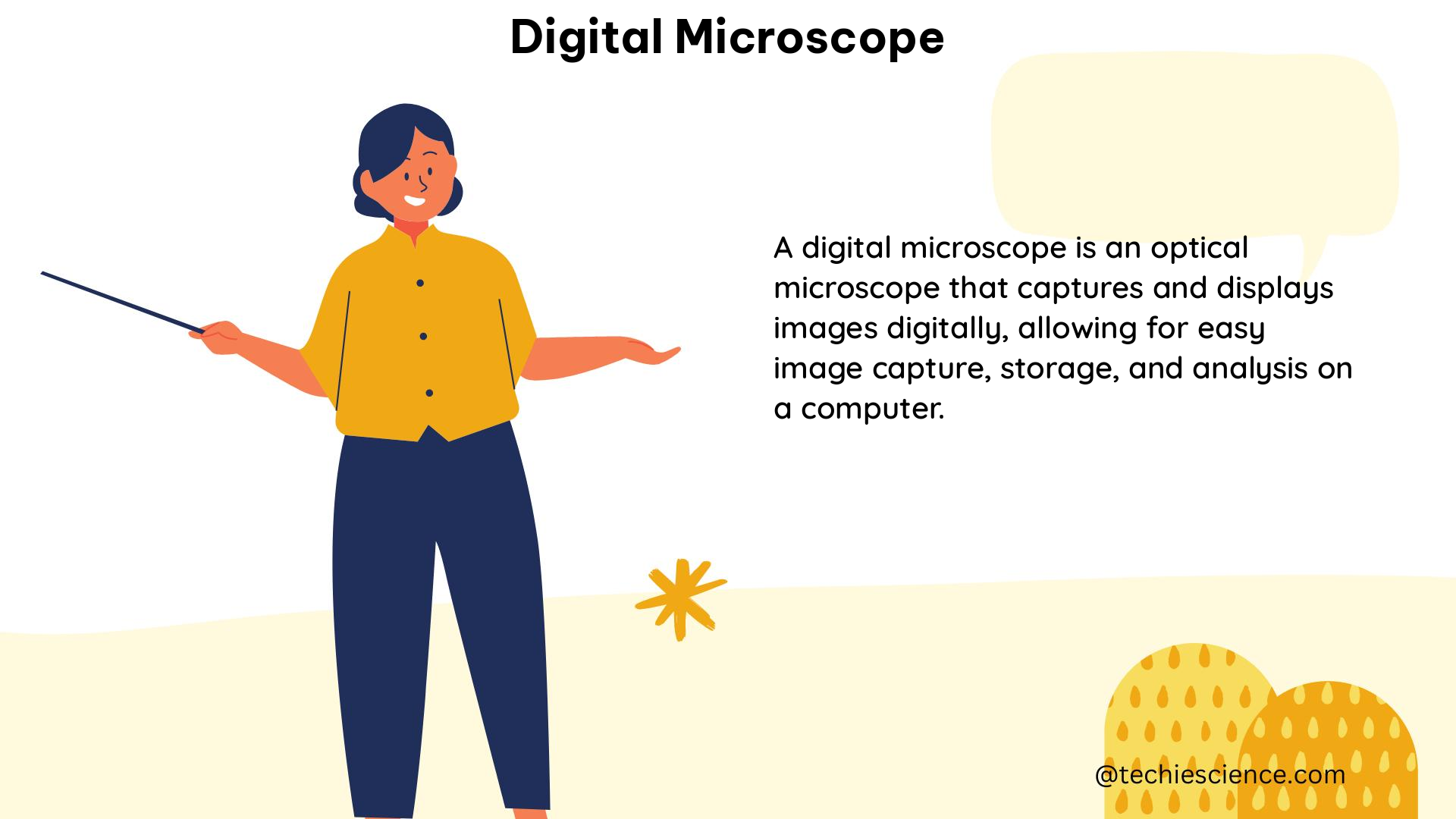Digital microscopes have revolutionized the world of microscopy, offering a range of advanced features and capabilities that surpass traditional optical microscopes. These powerful instruments provide researchers, scientists, and hobbyists with the ability to capture and analyze high-quality digital images with unprecedented precision and detail. In this comprehensive guide, we will delve into the technical specifications and advanced features of digital microscopes, equipping you with the knowledge to make informed decisions and unlock the full potential of these remarkable tools.
Resolution: Unveiling the Intricate Details
At the heart of digital microscopy lies the concept of resolution, which refers to the microscope’s ability to distinguish between two adjacent points. This critical factor is often measured in pixels per inch (PPI) or dots per inch (DPI). A high-quality digital microscope can produce images with a resolution of up to 1000 PPI, which is equivalent to 4K ultra-high definition (UHD) video. This level of detail allows users to observe and analyze the finest structures and features with remarkable clarity.
To understand the significance of resolution in digital microscopy, let’s consider a practical example. Imagine you are studying the intricate structure of a butterfly’s wing. With a traditional optical microscope, you may be able to see the overall pattern and general features of the wing. However, with a digital microscope boasting a resolution of 1000 PPI, you can delve deeper and observe the individual scales that make up the wing’s surface, revealing the intricate patterns and textures that are otherwise invisible to the naked eye.
Magnification: Expanding the Visible Realm

Magnification is another crucial factor in digital microscopy, as it determines the degree to which an image is enlarged. In digital microscopes, magnification is often expressed as a ratio of the size of the image on the screen to the size of the object being viewed. For instance, a digital microscope with a magnification of 100x can produce an image that is 100 times larger than the actual object.
This level of magnification allows users to explore the microscopic world in unprecedented detail. Imagine studying the structure of a single cell or the intricate patterns of a mineral crystal. With a digital microscope capable of 100x magnification, you can observe these tiny structures with remarkable clarity, unlocking a wealth of information and insights that would be impossible to discern with the naked eye.
Image Quality: Capturing the Essence of the Unseen
In addition to resolution and magnification, image quality is a crucial factor in digital microscopy. This aspect is often measured in terms of contrast, brightness, and color accuracy. High-quality digital microscopes are equipped with advanced imaging sensors and optics that can produce images with excellent contrast, brightness, and color fidelity.
Consider the study of a biological sample, such as a plant leaf or a tissue sample. With a digital microscope that offers superior image quality, you can observe the intricate cellular structures, the delicate patterns of the cell walls, and the vibrant colors of the chloroplasts with remarkable clarity. This level of detail and accuracy is essential for researchers and scientists who rely on microscopic observations to draw meaningful conclusions and make groundbreaking discoveries.
Software Capabilities: Unlocking the Power of Digital Analysis
The software capabilities of digital microscopes are equally important as their hardware specifications. Some digital microscopes come equipped with advanced software that can perform a wide range of image analysis tasks, such as measuring distances, counting objects, and identifying patterns.
Imagine you are studying the growth patterns of a bacterial colony. With a digital microscope that offers advanced software capabilities, you can not only capture high-resolution images of the colony but also use the software to precisely measure the size and distribution of individual bacterial cells. This level of quantitative analysis can provide invaluable insights into the growth dynamics and behavior of the colony, enabling you to draw more accurate conclusions and make informed decisions.
DIY Digital Microscopes: Exploring the Possibilities
While commercial digital microscopes offer a high level of performance and functionality, there are also opportunities for DIY enthusiasts to explore the world of digital microscopy. Some options include building a microscope using a smartphone or tablet camera, using a USB microscope, or constructing a microscope using a Raspberry Pi or Arduino board.
These DIY digital microscopes can be an excellent way to learn about the principles of microscopy and image analysis, as well as to experiment with different techniques and approaches. While they may not offer the same level of performance as commercial digital microscopes, they can still provide valuable insights and learning experiences for those interested in exploring the world of microscopy.
Quantifiable Data Points: Measuring the Capabilities
To further illustrate the impressive capabilities of digital microscopes, let’s consider some quantifiable data points:
- Resolution: A high-quality digital microscope can produce images with a resolution of up to 1000 PPI, which is equivalent to 4K ultra-high definition (UHD) video.
- Magnification: A digital microscope with a magnification of 100x can produce images that are 100 times larger than the object being viewed, making it possible to see details that are not visible with the naked eye.
- Measurement Accuracy: A digital microscope with advanced image analysis software can measure distances with an accuracy of ±0.1 microns, which is equivalent to 1/100th the width of a human hair.
- Image Formats: A digital microscope can capture images and videos in a wide range of formats, including JPEG, PNG, TIFF, and AVI, making it possible to share and analyze data in a variety of ways.
These data points highlight the remarkable capabilities of digital microscopes, demonstrating their ability to provide researchers, scientists, and hobbyists with unprecedented levels of detail, precision, and flexibility in their microscopic observations and analyses.
Conclusion
Digital microscopes have revolutionized the world of microscopy, offering a range of advanced features and capabilities that surpass traditional optical microscopes. By understanding the technical specifications and advanced features of these powerful instruments, you can unlock the full potential of digital microscopy and explore the microscopic world with unprecedented clarity and detail.
Whether you are a researcher, a scientist, or a hobbyist, the insights and capabilities provided by digital microscopes can open up new avenues of discovery and unlock a wealth of information about the intricate structures and processes that govern the natural world. By embracing the power of digital microscopy, you can push the boundaries of what is possible and contribute to the advancement of scientific knowledge and understanding.
References:
- Quantitative Analysis of Digital Microscope Images | Request PDF. (n.d.). Retrieved from https://www.researchgate.net/publication/6313881_Quantitative_Analysis_of_Digital_Microscope_Images
- Quantifying microscopy images: top 10 tips for image acquisition. (n.d.). Retrieved from https://carpenter-singh-lab.broadinstitute.org/blog/quantifying-microscopy-images-top-10-tips-for-image-acquisition
- Quantifying microscopy images: top 10 tips for image acquisition. (n.d.). Retrieved from https://forum.image.sc/t/quantifying-microscopy-images-top-10-tips-for-image-acquisition/12343

Hi, I am Sanchari Chakraborty. I have done Master’s in Electronics.
I always like to explore new inventions in the field of Electronics.
I am an eager learner, currently invested in the field of Applied Optics and Photonics. I am also an active member of SPIE (International society for optics and photonics) and OSI(Optical Society of India). My articles are aimed at bringing quality science research topics to light in a simple yet informative way. Science has been evolving since time immemorial. So, I try my bit to tap into the evolution and present it to the readers.
Let’s connect through